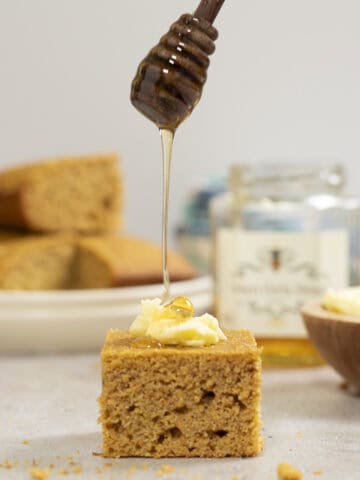Alaskan halibut and pesto are BFFs in this quick and easy recipe for sear-roasted halibut with macadamia pesto. You can use store-bought pesto in a pinch, but if you’ve got the time, my extra-rich and nutty macadamia nut pesto takes this dish to the next level. Don’t skip the sweet, garlicky tomatoes on top!

Last June, my resident hunter+gatherer (Mr. Parsley & Parm) brought back 80 POUNDS of Alaskan halibut from a fishing trip. I was over the moon – and a little jealous that I didn’t get to go too. We set to work cooking the mountain of fish in our freezer, but by August I was thinking, maybe I don’t like halibut? I could not, for the life of me, figure out how to make it turn out anything but dry.
Most of the fish I’ve cooked in my life are oilier than halibut, and I discovered the hard way that techniques for cooking oily fish like salmon and cod do not always apply to Alaskan halibut. It took some research, and some practice, but I finally turned a corner with this sear-roasted halibut with macadamia nut pesto. My kids say it’s the best halibut recipe I’ve ever made.
Secret #1 for the perfect Alaskan halibut: add healthy fat
Halibut is extremely low in fat, which accounts for its tendency to turn dry the moment it turns flaky. It also has a mild flavor, making it a versatile choice to work with a variety of strong flavors. These two things make the extra-rich, extra-nutty macadamia nut pesto a perfect match for this fish. Traditional pesto works too, and you won't be sad you used either one.
This dish is also topped with sweet, garlicky tomatoes that are ever-so-slightly cooked by pouring hot, garlicky EVOO over them. The acidity of the tomatoes offsets some of the richness of the pesto and balances the dish nicely. An extra bit of garlic-infused oil adds even more yum to the final product.

Secret #2 for the perfect Alaskan halibut: watch the temperature!
The secret is not just in the technique, but also in the use of a meat thermometer. Most fish recipes say something like “cook until the fish is opaque and flaky.” I’ve only rarely seen an option for cooking fish to a specific temperature. This has repeatedly led me to mangle my halibut with a fork to figure out if it was done. Now, I monitor the temperature with my Thermapen thermometer. It lets me be precise about when I pull the fish off the heat.
Alaskan halibut is thicker than most fish cooked in home kitchens, so it can be hard to get it right. I start by searing the fish for 5 minutes, then turning it over and adding the macadamia nut pesto. Right away, I slide it in the hot oven for a few more minutes. I check the temperature after 5 more minutes, and pull it just before it’s done, about 125 degrees F. The fish continues to cook in the pan, and arrives gently at the perfect temperature, about 130 degrees F.
*DISCLAIMER: The FDA considers fish cooked to 130 degrees to be undercooked. Please use caution when consuming undercooked fish and shellfish.

Tips for cooking sear-roasted Alaskan halibut with macadamia nut pesto
- For the perfect sear, dry the fish well before seasoning. This is true for any fish or meat that you want to get a crust on, it must be dry when it hits the heat. Use paper towels to soak up as much moisture as possible from the surface of the fish before adding any seasoning.
- Get your pan hot before adding the fish. To get a nice sear, the surface of the fish needs to go straight into a hot pan. The chemical reaction that produces that lovely color and flavor happens at a high temperature. The outside needs to cook quickly before the inside of the fish overcooks.
- Experiment to find out how you like your fish. Halibut is well done at somewhere around 145 degrees, but I prefer it around 130. If you want consistently good fish, cooked to your liking, it helps to practice a little. Remember, you can always cook fish a little more, but can’t uncook it. I recommend taking it out at 125 the first time, and putting it back in the oven if you find you prefer it more well done.
Macadamia nut pesto can be prepared up to three days in advance; everything else should be prepped just before you cook. Leftover fish will keep for 1-2 days in your refrigerator.
Sear-Roasted Alaskan Halibut with Macadamia Nut Pesto
Equipment
- Small saucepan
- Non-stick pan
- Fish spatula
Ingredients
- 1 cup cherry tomatoes, cut in half cut in quarters if large
- 2 cloves garlic, thinly sliced
- 5 tablespoons extra-virgin olive oil divided
- 1 ½ pounds Alaskan halibut or other firm white fish, cut into four equal pieces
- ½ cup macadamia nut pesto or store bought pesto
- salt and freshly ground black pepper
- granulated garlic
Instructions
- Position a rack in the center of your oven and preheat it to 450 degrees.
- Place the diced cherry tomatoes in a small heat-proof bowl. Add a pinch of salt and a couple of cranks of black pepper and toss to incorporate.
- In a small, shallow pan, heat 3 tablespoons of olive oil over medium low heat, then add the garlic slices. Sauté until the garlic is fragrant, but not browned, 1-2 minutes, then turn off the heat and let sit for a few minutes. Pour the warm garlic and oil over the tomatoes and toss them together. Set aside.
- Make sure the fish pieces are dry, and season them with salt, pepper, and granulated garlic.
- Heat 2 tablespoons of olive oil in an oven-proof skillet over medium-high heat. Add the fish, flesh side down and evenly spaced. Cook until the fish browns and releases from the pan, about 4-5 minutes. Flip the fish over and quickly spread a tablespoon or so of pesto over each piece.
- Transfer to the oven and roast for 5 minutes, then check the internal temperature. You are aiming to take the fish out somewhere between 125-130 degrees F. Cooking time will vary based on the thickness of your fish. I highly recommend a Thermapen-type thermometer when cooking thick pieces of fish.
- Remove from the oven and allow to sit for 5 minutes before serving. Transfer the fish to plates and top with the tomato-garlic mixture.
Need more servings?
To adjust a recipe for more or fewer servings, hover your cursor over the number servings on the recipe card. This will bring up a slider that you can move to the number of servings you want to make.
Nutrition

PIN THIS RECIPE!
RELATED RECIPES









Leave a Reply